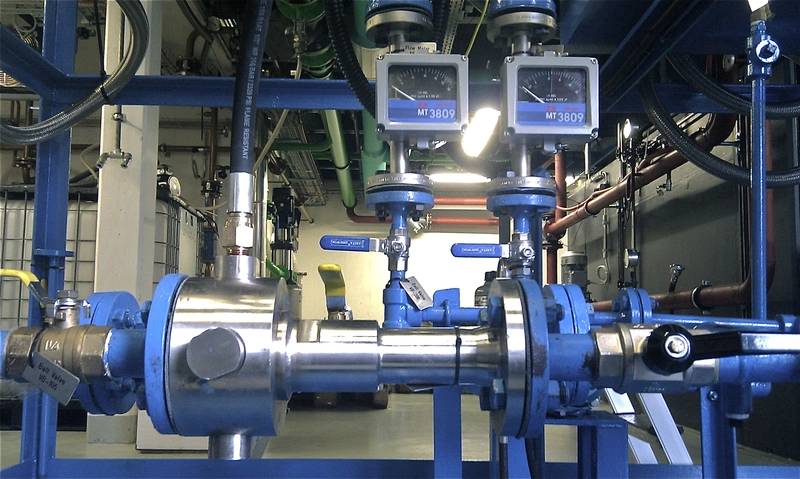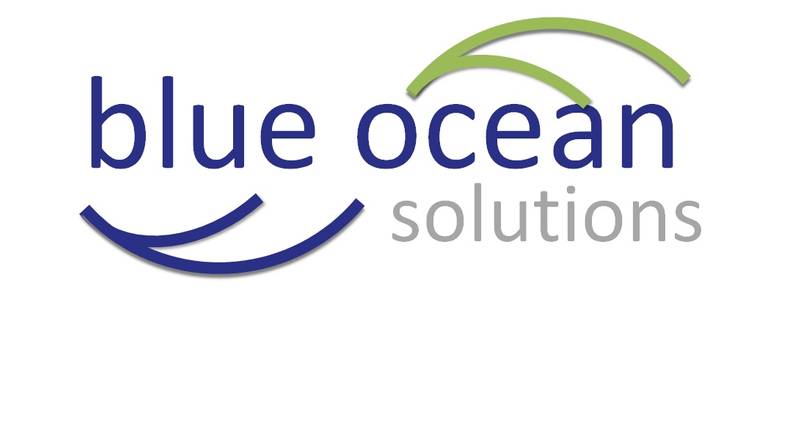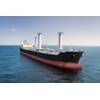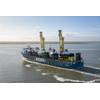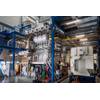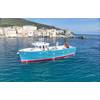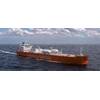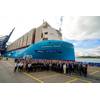Oil & Water do Mix
Emulsified Fuel Tech Earns a Better Rep
Matters of fuel use, economy and emissions are “A-List” items on any vessel owner’s agenda, as skyrocketing prices for diesel and a spiraling maze of regulation regarding fuel content and emissions are pressing owners to adopt technical solutions. Maritime Reporter & Engineeing News recently spent some time with Dr. Jerry Ng Kok Loon, the founder and CEO of Blue Ocean Solutions, and one of the industry’s leading experts within emulsified fuel technology.
Your company was created in late 2010, but actual research into your emulsified fuel technology stretches back to the 1980s. Can you please explain?
When we did the research work in the 1980s, the price of oil was so cheap that it would have not been feasible for the ship owners to invest on the system. Blue Ocean Solutions was established as a response to the need for fuel savings solutions due to escalating fuel prices. Today, 3% improvement in fuel efficiency is significant. With our system, a ship owner spending 30-40 metric tons a day, for example, would save $150,000 to $200,000 per year at today’s HFO price.
We understand the premise behind emulsified fuel technology, but we also understand that it is not always highly regarded in the marketplace?
Water in fuel emulsion has been around a long time. Over the past decades, the research has mainly been focused on NOx reduction. Our focus on the other hand has always been on fuel savings, to understand what kind of emulsion produces more complete combustion. It is true that water in fuel emulsions have had bad reputation mainly because not enough research work has been done. The idea is simple, adding water into the fuel but the reality is far from simple. Extensive research works have been carried out in established research laboratories and Universities all over the world for decades. The results at test beds have proven that emulsified fuel have consistently improved fuel efficiency and reduce NOx. These results have been well published and reviewed. However, when they were applied to ship board applications at sea, the good test bed results have eluded almost every tested emulsified fuel systems.
The key reason is in the reliability and ability of the emulsifier to produce water-in-fuel emulsions with consistent water-in-fuel particles sizes of 2-6 microns. Under real sea and engine room conditions, all current emulsifiers either produce water-in-fuel water particles sizes of well below 2 microns or well above 6 microns. Theoretical and experimental research have established the optimum water-in-fuel particle sizes for 10% water v/v emulsions must be between 2-6 microns for secondary atomization to occur.
The key in emulsified fuel is to create the secondary atomization effect where water particles in the fuel explodes creating a finer fuel mist and therefore more complete combustion. To understand this is one thing and to know the characteristics of the optimum emulsion. The challenging part is to produce the emulsion consistently. We have done extensive research in emulsified fuel to understand the theory and the practice. We also started our work using homogenizer, but found out that after a short time the performance always drops. Homogenizer has mechanical moving parts and especially, in engine room environment, there will be wear and tear quickly which causes the performance to deteriorate.
The key innovation in Emulsified fuel technology is the development of our Emulsified that has no moving parts. Our Emulsifier produces that correct emulsion for best fuel savings (guaranteed and proven minimum 3% savings). There is no storage of emulsion, neither do we use any chemicals, even with MGO. So it works reliably.
How much does your systems cost to install?
The installation is rather fast and simple. When the ships is at port we would prefabricate our emulsifier module and install 3 change over valves. The rest we can do while the ship sails. It would take about 3-4 weeks if the installation is done while the ship is sailing and less than one week on a drydock. The cost of installation depends on the ship’s fuel oil supply system and the price of the used man power, naturally. Also, the cost will be different if the installation is done during the drydock or while the ship sails. Roughly, the installation would be couple of tens of thousands.
What are the maintenance factors?
With our EFS, the maintenance requirements are a minimum. The only moving part of the system is the HP water pump that requires scheduled maintenance every six months. The key part of our system and also the key innovation in Emulsified Fuel technology is our Emulsifier that has no moving parts. The advantage compared to more conventional type homogenizer is that there is no wear and tear of the mechanical moving parts. The performance will not deteriorate. We have taken our emulsifier apart after over a year of operation and found that wear and tear were negligible when critical parts were sent to metrological laboratory for inspections. Our EFS is a total system. We have not only considered the performance of the system and ease of installation but also the ease of operation is important. The system is fully automated and fail safe with safety interlock built in. If there is an alarm, the EFS will shot down automatically and revert to the normal fuel oil service system.
With increasing fuel costs and tightening environmental regulations, the guarantee of 3% fuel savings and NOx reduction would seemingly make installation of the system a “no-brainer”. That said, what are the most common objections you hear, and how are they overcome.
The urgent need for fuel saving solutions has also increased the number of companies and people coming to market with claims of fuel savings. Some are credible but too many are not. Ship owners are careful. Emulsified fuel technology has also had a bad reputation. Not enough research work has been done to fully understand what kind of emulsion achieves fuel savings, not to mention how to produce that kind of emulsion reliably and consistently.
Ship owners are also concerned if there’s any damage to the engine condition, even though engine manufacturers already accept water in fuel emulsion as an alternative fuel. Furthermore, MAN, for example, has stated that their FWE “has proven not to affect the reliability of the engine,” after running some years. We have also surveyed the engine condition on our each reference after 6k hours and found no adverse effect on the engine condition. In fact we have found that the engine parts are cleaner. With our latest reference, a Cruise Liner, the engine manufacture has surveyed the condition of the engine and found no “show-stoppers.” The ship owner continues to run our Emulsified Fuel System after over a year now and continue to save fuel.
Also, the verifications of actual fuel savings at sea is a very delicate tasks that require deep experience and careful planning. Based on our experience, there is a lack of expertise in this area. The common experience to date is measuring of specific fuel consumption to ISO standards of +/- 3% deviation but not in measuring of % fuel efficiency improvement of the order of a few %. It is obvious that it is not possible to measure % fuel savings of a few % reliably and accurately by relying on a methodology that have permissible deviation of specific fuel consumption of +/- 3%. Ship owners demand a methodology that they can trust. Ship owners confidence have been lost over the years specifically because % savings declared were not trusted. At BOS, we have the experience and methodology that can prove to ship owners the % savings achieved reliably and accurately.
What are the advantages of being a subsidiary of Keppel Offshore & Marine?
Keppel’s strategy is Near Market, Near Customer. With global network of 20 yards and offices, customers is assured of excellent technical and service support backed by a strong and reliable reputation.
Are there size limitations as to where the system can be installed?
There are no size limitations. Our Emulsified Fuel System can be installed to a new engine, old engine, small or large, medium and slow speed.
What do you consider to be the biggest challenge(s) to having your solution more widely adopted throughout the maritime industry?
The biggest challenge is to deliver fuel savings to ship owners (according to ISO standards) that are reliable, dependable and trusted and which are verifiable by independent third party, and without any adverse effects to the diesel engine. There are no short cuts and these require careful planning and time. We started in late 2010 with installation in late 2011. We are now at the point of delivering such trusted results. Cost-benefits is not a challenge because the ROI is well below the commonly expected 3 years. In fact, at current equipment cost versus fuel savings, the ROI is well below 1-1.5 years.
Dr. Jerry Ng Kok Loon
The founder and CEO of Blue Ocean Solutions, Dr. Jerry Ng Kok Loon is one of the industry’s leading experts within emulsified fuel technology. He graduated with a Marine Engineering degree from the University of Newcastle upon Tyne and then worked with Prof RV Thompson on the applications of emulsified fuel to marine diesel engines as a research assistant in the 1980’s while working on his doctorate degree. He continued his research work in emulsified fuel system at the Nanyang Technological University in Singapore with the support of the National Science Council and Neptune Orient Lines. Currently, Dr. Jerry has two patents with several pending on emulsified fuel technology.
Blue Ocean References
- Wärtsilä, Hercules Project
Medium speed engine, 2-stage miller cycle using MGO
- Cruise Liner, HQ in USA
Medium speed engine using HFO, MDO
- B&I, Connaught
RoRo Ferry, medium speed engine using HFO
- Townsend Thoresen, Spirit of Free Enterprise
RoRo Ferry, medium speed engine using HFO
- London Overseas Freighters, MV London Viscount
Bulk Carrier, slow speed engine using HFO
- NOL, Neptune Crystal
Container, slow speed engine using HFO
(As published in the January 2013 edition of Maritime Reporter - www.marinelink.com)





